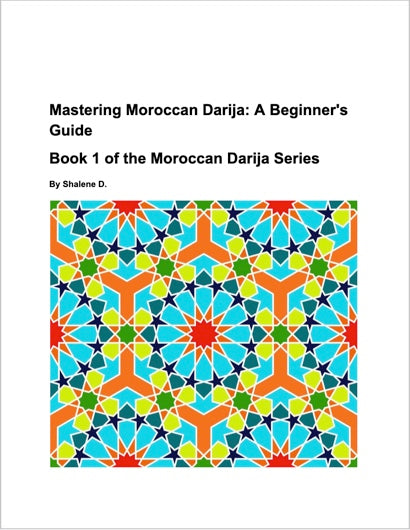Darija Drop
Mastering Moroccan Darija: A Beginner's Guide
Mastering Moroccan Darija: A Beginner's Guide
Couldn't load pickup availability
Welcome to "Mastering Moroccan Darija: A Beginner's Guide", the first book in a comprehensive 5-part series aimed at helping you achieve fluency in Moroccan Darija. Whether you're planning to visit Morocco, reconnect with your heritage, or simply fascinated by the language, this book is designed to guide you step-by-step into the world of Moroccan Darija.
What You'll Learn in Book 1
By the end of this book, you will:
-
Be able to understand and use basic greetings and polite phrases for starting conversations, showing respect, and making connections in Morocco.
-
Learn the unique sounds of Moroccan Darija and practice using Latin letters and numbers to represent those sounds.
-
Form simple sentences and questions, including greetings, asking for help, talking about daily activities, and expressing basic needs.
-
Gain a foundation in essential grammar and sentence structure, including pronouns, verbs, and negation.
-
Become familiar with common vocabulary used in daily life, covering topics such as food, household items, and common expressions.
-
Learn to count in Darija up to 1,000, which will enable you to talk about time, age, quantities, and prices.
-
Understand how to use feminine and masculine nouns and adjectives appropriately in sentences.
Also Check out the corresponding Workbook which includes 20 exercises for each chapter of Book 1 to help solidify all you've learned! Packages available!
The Moroccan Darija Series Overview:
-
Book 1: A Beginner's Guide - Introduction to essential phrases, pronunciation, and vocabulary.
-
Book 2: Intermediate Level – Expanding vocabulary and grammar to improve daily conversation skills.
-
Book 3: Advanced Grammar and Specialized Vocabulary – Focus on cultural insights and different contexts.
-
Book 4: Real-World Application – Storytelling, debating, and handling more advanced conversations.
-
Book 5: Fluency – Mastery through advanced communication, media immersion, regional variations, and nuanced expression.
Share


